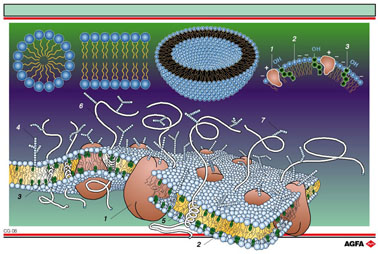CG06 Cell membrane
| Aim:
To demonstrate the corpuscular arrangement of amphipatic materials
in water - the structure of cell membranes. |
Amphipatic
materials aggregate in water to form larger particles, with the polar
heads orientated towards the water and the apolar tails gathered together
in a waterfree zone. This is called hydrophobic interaction.
Micelles
(left), and bilayers (middle) that can also be spherical (middle right),
result from these interactions.
Cell
membranes are built up out of such an amphipatic phospholipid bilayer.
Two aqueous phases, cell content and extra-cellular water, are separated
from each other by an apolar layer (fatty acid tails) originating from
phospholipids (2) and cholesterol (3). Globular proteins (1), glycoproteins
(6) which can contain a helical structure (5) and are bonded to sugar
chains (7), and glycolipids (4) protrude through this layer.
The globular proteins are chiefly responsible for the transport of polar
compounds through the membrane.
